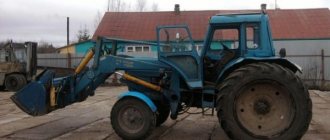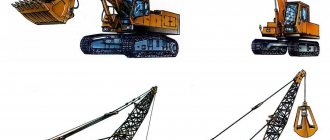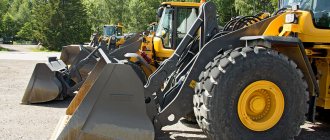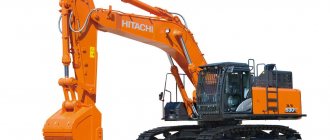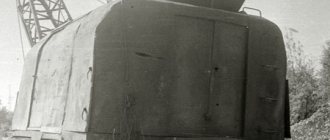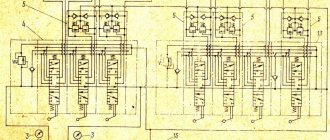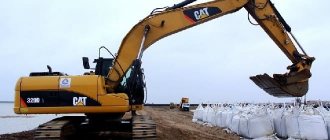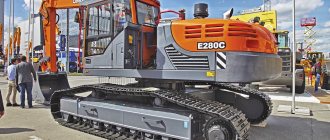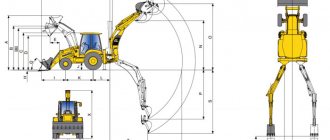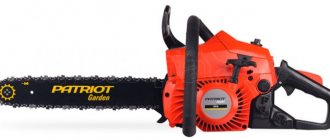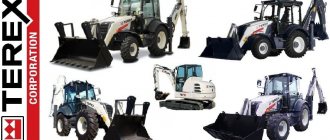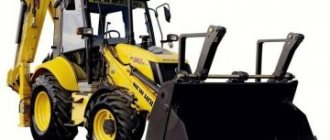What is a backhoe loader, history of creation
This type of engineering machines appeared in the middle of the last century. As you can easily guess from the name, they appeared by crossing an excavator and a front-end loader. Although, of course, everything happened a little more complicated.
JCB and Case are still arguing for the right to be called the creator of this technology. However, officially, Joseph Cyril Bamford, the founder of JCB, is considered the inventor of the backhoe loader. And that's why.
Excavator bulldozer
The development of technology in the first half of the 20th century made it possible to use a hydraulic drive in controlling an excavator bucket. Hydrofication of equipment made it possible to create mounted excavator equipment, which was installed on an agricultural wheeled tractor. The most suitable place for him was in the back of the car.
The driver's seat is made to swivel for ease of operation of the operator. However, the distribution of the car's weight along the axles has changed, and the steering axle has become almost uncontrollable. Therefore, a straight bulldozer blade was mounted in front. While working with excavator equipment, it served as a counterweight and outrigger. The car turned out to be relatively inexpensive and mobile.
Transformation into a backhoe loader
Improvement of the excavator-bulldozer began immediately after its appearance: alteration of the tractor, modification of attachments. During loading operations, the machine was much inferior to the loaders. Instead of a bulldozer blade, they began to attach loading equipment to parts of JCB machines, but the small swivel wheels of an agricultural tractor with a U-shaped mount could not withstand the loads.
The market niche discovered by Joseph Bamford was recognized by the larger Case firm. She was the first to create a special chassis: a reinforced front axle; frame designed for loads typical for forklifts; modified transmission ratios, and then a hydromechanical gearbox; spacious cabin for reverse control.
Thus was born a new type of earthmoving and transport utility vehicles - backhoe loaders. Today they are produced by dozens of foreign companies. JCB remains one of the leaders. Major manufacturers are Case, Caterpillar, Komatsu, Volvo, Terex, LiuGong, XCMG and others.
In Russia, the evolution of the production of such machines repeats what is described above. The only, unfortunately, sad fact remains that the production of full-fledged backhoe loaders is carried out by only a few companies - ElAZ, RM-Terex (at the Tver Excavator Plant) and KEMZ. And even then, all the machines are licensed developments of foreign companies.
The Belarusian Amkodor is conditionally domestic. The company is also actively developing the niche of backhoe loaders. However, like other domestic manufacturers, they produce attachments that are installed on agricultural tractors, in particular MTZ, YuMZ.
M317D2
This is a wheeled excavator with a fairly high useful power - 102 kW. It also has a good speed of up to 37 km/h. Caterpillar has used a number of advanced developments to expand the functionality and provide superior technical performance of this series of excavators. Increased equipment lifting capacity helps reduce operating costs and increase productivity.
Also, the M317D2 machines have simplified controls and reduced cycle times, which allows for faster work completion. All daily maintenance points are easily accessible from ground level, making maintenance and repairs easier. All critical components are supplied with lubricant by a centralized system. The cabin is equipped with a rear view camera and a color display, which ensures safe operation of the excavator and ease of control.
Technical characteristics of backhoe loaders
Backhoe loaders are perhaps the most striking combination machines. They took place as an independent type of earth-moving and municipal equipment. Like any other class of technology, they have common features, regardless of the manufacturer.
The main elements of this earth-moving equipment are the working parts: a loading bucket at the front (a bulldozer bucket with a jaw grip is more often used); backhoe boom with backhoe and base machine.
All models, with rare exceptions, have a four-cylinder diesel engine with an average power of 60 to 110 hp. The power unit can be turbocharged, electrical or mechanical fuel injection.
Interesting fact!
In 2022, the Case Zeus 580 EV all-electric backhoe loader was unveiled at Conexpo-Con/AGG. Other companies have also announced the creation of battery-powered cars. However, these are all prototypes and equipment for field testing, not yet presented on the commercial market.
This equipment is produced mainly in a wheeled version. If we consider a full-fledged backhoe loader, and not an attachment to an agricultural tractor, several chassis options have been developed for them:
- conventional with rear-wheel drive and steered front wheels of smaller diameter;
- a chassis with equal-sized wheels and, as a rule, all-wheel drive;
- machine with an articulated frame.
The most common are the first two options. Manufacturers of backhoe loaders strongly emphasize the versatility of their machines. Taking into account possible cramped working conditions, various types of soil surfaces, the equipment has three steering options:
- Normal, with steered front wheels.
- Full turning, when the front wheels turn in one direction and the rear wheels in the other, following the same track as the front wheels (track to track) and thereby reducing the turning radius.
- A crab move, when the front and rear wheels turn in one direction and the car moves half sideways.
It must be said that the wheeled chassis, although not a mounted implement, provides another and very important function - mobility. Wheeled vehicles are more mobile than tracked ones. Although in some conditions, more passable tracked vehicles are chosen as a base for a backhoe loader.
Links
Wiktionary has an entry for "excavator"
- Excavator
- article from the Great Soviet Encyclopedia. - [krugosvet.ru/enc/nauka_i_tehnika/tehnologiya_i_promyshlennost/EKSKAVATOR.html Excavator] - Universal online popular science encyclopedia Around the World.
- [dic.academic.ru/dic.nsf/enc_geolog/5621 Excavator] - on the Akademika.ru website.
| : Incorrect or missing image | To improve this article it is desirable:
|
Scope of application
The main advantages of the backhoe loader: maneuverability and versatility. That is why they are widely used in public utilities and construction. Compact and maneuverable - used in small areas, in public utilities. More powerful ones are in the construction and agricultural sectors. Tracked backhoe loaders are used in wetlands and forestry.
Standard backhoe loader attachments allow them to be used as wheeled excavators, front-end loaders and bulldozers. Digging trenches for laying pipelines, excavating soil in construction and agriculture, landscape design, loading and unloading operations, clearing the area of debris - this is only a small part of the machine’s capabilities.
The variety of tasks has led to the development of interchangeable attachments. Widespread:
- Hydraulic hammer. Used to destroy walls and road surfaces.
- Folding forks. They are installed directly on the bucket and are designed for loading and unloading pallets.
- Leveling bucket. For landscaping, roadside planning, snow removal.
- Brushes. Cleaning streets and highways.
- Vibrating plate. Designed for compaction of various soils and asphalt surfaces.
- Boer. Well drilling, incl. for installation of support pillars and piles.
The list of equipment goes on; even buckets are offered in several options, depending on the purpose of using the equipment. Loaders with brush equipment have taken root in the public utilities sector. To speed up work with replaceable equipment, a special device has been developed for quickly replacing the working element without leaving the cab.
Common models, their brief characteristics
The popularity and demand for backhoe loaders on the market contributes to the emergence of a wide selection of models, brands and configurations. Manufacturing plants use original design solutions, offer various layouts and attachments, so there is a large selection of machines for specific purposes.
The leader in the number of backhoe loaders sold in the world is the English company JCB
. Common to its models is a gear and reverse switch, which allows you to quickly change the speed and direction of movement, including under load, without stopping the machine. The most popular models are 3CX and 4CX.
JCB equipment is equipped with a DieselMax diesel engine. The EcoLoad system, working in tandem with the power unit, allows for high torque at low speeds. Panoramic glazing in the cab of JCB backhoe loaders provides excellent visibility to the driver. The one-piece rear glass eliminates blind spots and allows the operator to control the digging process.
Read
“Review of the market for imported backhoe loaders”
Other renowned manufacturers also have this type of equipment in their product line. On Russian roads you can find backhoe loaders from Caterpillar, John Deere, Volvo, Case, Komatsu. Turkish cars MST and Hidromek, Chinese SDLG, XCMG and others are not uncommon.
John Deere Company
has been officially supplying construction equipment to the Russian market since 2009. Backhoe loaders are presented in two models – 315SL and 325SL. The equipment is equipped with turbocharged diesel engines PowerTech 4-liter John Deere of environmental class Stage II, with a power of 94 hp. and 97hp respectively.
The lower environmental class of power plants is due to the unstable quality of Russian diesel fuel, which negatively affects the performance of high-tech foreign diesel engines. To increase “stress resistance” to Russian diesel fuel with a high content of sulfur, moisture and impurities, the engines are equipped with a two-stage filtration system, two water separator bowls on fuel filters and a sensor for the presence of water in the fuel. Other systems are also developed based primarily on the principles of simplicity and reliability.
XCMG line
There are four models of backhoe loaders - WZ30-25, XT860, XT870, XT876. The WZ30-25 model is equipped with a hydraulic control system for working bodies based on the principle of a single lever (joystick), which allows for combined excavation, provides ease of use and high efficiency. The working device to choose from includes a hydraulic hammer, vibrating rammer or 4-in-1 bucket. For all machines, an HB3G hydraulic hammer and rammer are offered as additional equipment.
A few years ago, Chinese equipment was among the cheapest, but now the leading machine-building companies in the Middle Kingdom are bringing the quality of their machines up to European standards, and their prices are also going up.
Domestic manufacturers produce backhoe loaders mainly in the form of attachments for wheeled tractors MTZ, VTZ, YuMZ. They are produced as full-fledged equipment by the Tver Excavator Plant (RM-Terex), KEMZ and ElAZ. But all this is a licensed assembly of foreign models.
RM Terex
offers the TLB 825 model with a Perkins engine. The hydraulic system ensures smooth operation and significantly reduces the time of the full operating cycle. The hydraulic cylinders of excavator and loading equipment are double-acting, which allows quick switching between units.
When the vehicle moves independently on public roads, the rear axle is the driving one. In case of moving through difficult terrain, front-wheel drive is also connected.
Read
"Backhoe loaders from Russian and CIS countries"
The Yelabuga ElAZ plant offers two models of backhoe loaders - BL 880 and BL 888. Both models are equipped with a 100 hp Perkins engine. The first option is more budget-friendly.
By chassis type
Options for constructing load-bearing chassis for excavators:
1. Floating - perform work on water surfaces, under water.
2. Land:
- walking, moving on supporting legs or shoes;
- tracked;
- pneumatic;
- on rails;
- specialized;
- on a tractor;
- all-terrain.
3. Combined - simultaneously equipped (retractable, lowerable) chassis of different types.
